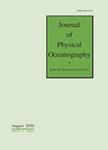版权所有:内蒙古大学图书馆 技术提供:维普资讯• 智图
内蒙古自治区呼和浩特市赛罕区大学西街235号 邮编: 010021

作者机构:Max Planck Inst Meteorol D-20146 Hamburg Germany Int Max Planck Res Sch Earth Syst Modelling Hamburg Germany Norwegian Meteorol Inst Oslo Norway
出 版 物:《JOURNAL OF PHYSICAL OCEANOGRAPHY》 (物理海洋学杂志)
年 卷 期:2015年第45卷第12期
页 面:3119-3135页
核心收录:
主 题:Circulation Dynamics Internal waves Waves oceanic Atm Ocean Structure Phenomena Tides Observational techniques and algorithms Satellite observations Mathematical and statistical techniques Spectral analysis models distribution Models and modeling Ocean models
摘 要:Using a concurrent simulation of the ocean general circulation and tides with the 1/10 degrees Max Planck Institute Ocean Model (MPI-OM), known as STORMTIDE, this study provides a near-global quantification of the low-mode M-2 internal tides. The quantification is based on wavelengths and their near-global distributions obtained by applying spectral analysis to STORMTIDE velocities and on comparisons of the distributions with those derived by solving the Sturm-Liouville eigenvalue problem. The simulated wavelengths, with respect to both their magnitudes and their geographical distributions, compare well with those obtained by solving the eigenvalue problem, suggesting that the STORMTIDE internal waves are, to a first approximation, linear internal waves satisfying local dispersion relations. The simulated wavelengths of modes 1 and 2 range within 100-160 and 45-80 km, respectively. Their distributions reveal, to different degrees for both modes, a zonal asymmetry and a tendency of a poleward increase with stratification N and the Coriolis parameter f being responsible for these two features, respectively. Distributions of mode 1 wavelengths are found to be determined by both N and f, but those of mode 2 are mainly controlled by variations in N. Larger differences between the STORMTIDE wavelengths and those of the eigenvalue problem occur, particularly for mode 2, primarily in high-latitude oceans and the Kuroshio and Gulf Stream and their extensions.